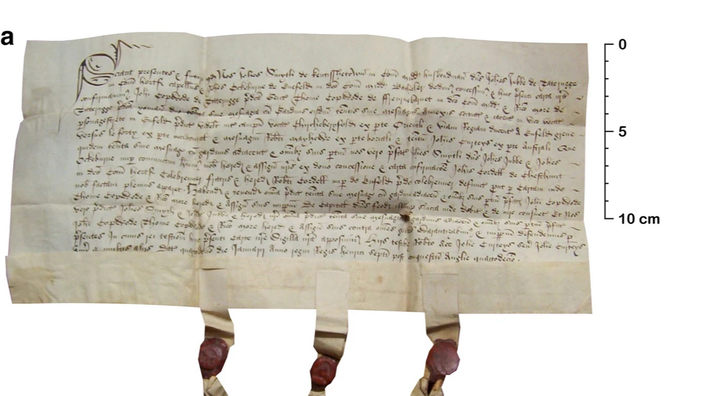The idea of an obscure and ignorant European Middle Ages is tough.
Destroyed for a long time by the many developments of research in History, the image of Épinal of a backward medieval period has had its day;
it will perhaps be even more so thanks to the discovery made by a group of British researchers.
All this thanks to biocodicology, the study of manuscripts through their biological data.
A group of scholars from the universities of Exeter, York and Cambridge examined the surprising properties of sheepskin which, since at least the Middle Ages, have been put to good use by generations of scrupulous Anglo-Saxon scribes. .
Read also: In the Middle Ages, women were also copyists
At the source of the investigation carried out by British academics was a historical question: how to explain the prolonged use of parchment in notarial deeds - documented until the beginning of the 20th century - when it is much more expensive than the paper medium, the use of which gradually became popular in modern Europe, in the 16th-17th centuries?
The main argument, well known, is due to the good conservation capacity of the support, which had already earned it to be preferred, during Antiquity, to the too fragile and brittle papyrus.
Yet upon close examination of a corpus of over 600 parchments drawn from 477 English, Welsh and Scottish notarial and legal documents dated to the late 16th to early 20th centuries, British scientists realized that another property, d physiognomic order, could have been taken into consideration.
Something, in fact, was wrong with the fact that the studied parchments were in a very overwhelming majority (96.4%, even 100% taking into account the margin of error) made in sheepskin.
This preference was too important to be the result of mere chance.
Make the skin with the strikes
However, as the researchers indicated, the origin of this handwritten domination of the sheepskin can be traced to the Middle Ages.
"
Sheepskin parchment was preferred to that of calf or goat for legal acts, a choice which dates back at least to the 13th-14th century in England, Wales and Ireland,
" observed in the scientific journal
Heritage Science
the various authors of the study.
Why this overwhelming preference?
According to the researchers, the specific properties of the dermis of sheepskin - at a very high concentration of lipids - facilitate its degradation during the various stages of the preparation of the parchment.
The support obtained was of great finesse and made it possible to clearly highlight "
any concealment or redaction of the text
".
To read also: The monks already used the at sign "@" in the Middle Ages
It is easy to imagine, with such an anti-fraud guarantee, the naturally privileged support that these sheepskins were supposed to constitute for all notarial and legal literature, whose "
propensity to delaminate and to deform when scratched, exposes clearly any attempt to modify the text after it has been signed,
”the scientists said.
What to avoid having to deal with regrettable palimpsests.
A quality that medieval clerics were very early aware of even at the highest levels of the State, as attested by a written recommendation of Lord Treasurer Richard FitzNeal, in the 12th century, slipped into the treatise
of Scaccario's Dialogus
which is for him. assigned.
As the British researchers point out, several other logistical factors also played a role in this domination of the sheepskin parchment, in the first place the very affordable price of the animal, thanks to the importance of the sheep herd in the British islands.
Another factor: the scarcity and prohibitive price of vellum - the calfskin parchment, of great quality and extreme finesse - never allowed it to compete with the sheepskin, which was only knocked down with the rise of industrial paper.
Associated with its useful dermal physiognomic properties, this is ultimately a large number of qualities that the animal held pegged to the body.
And enough to understand why the British clerics have so long reluctant to make the skin to the skin of sheepskin.

